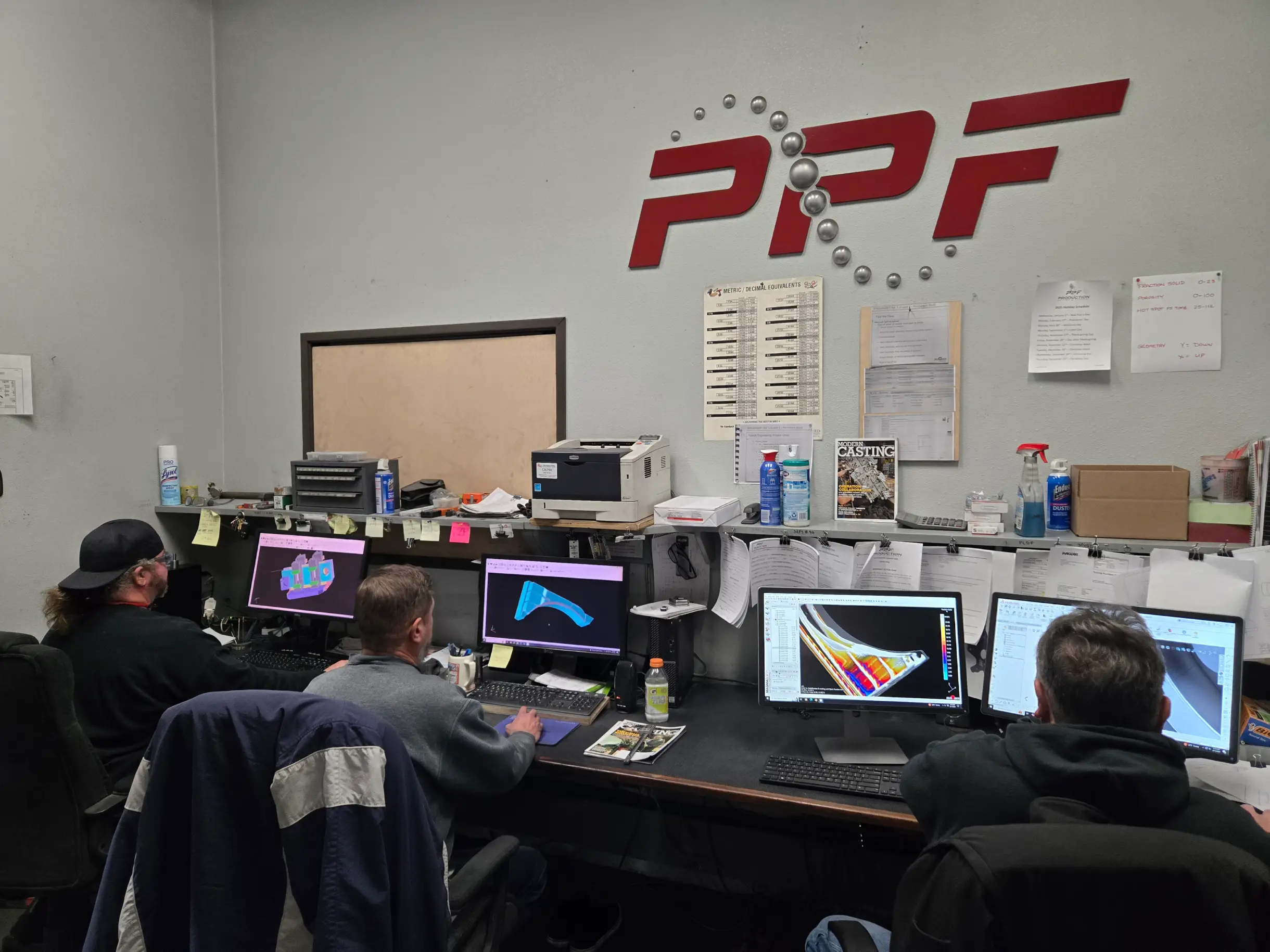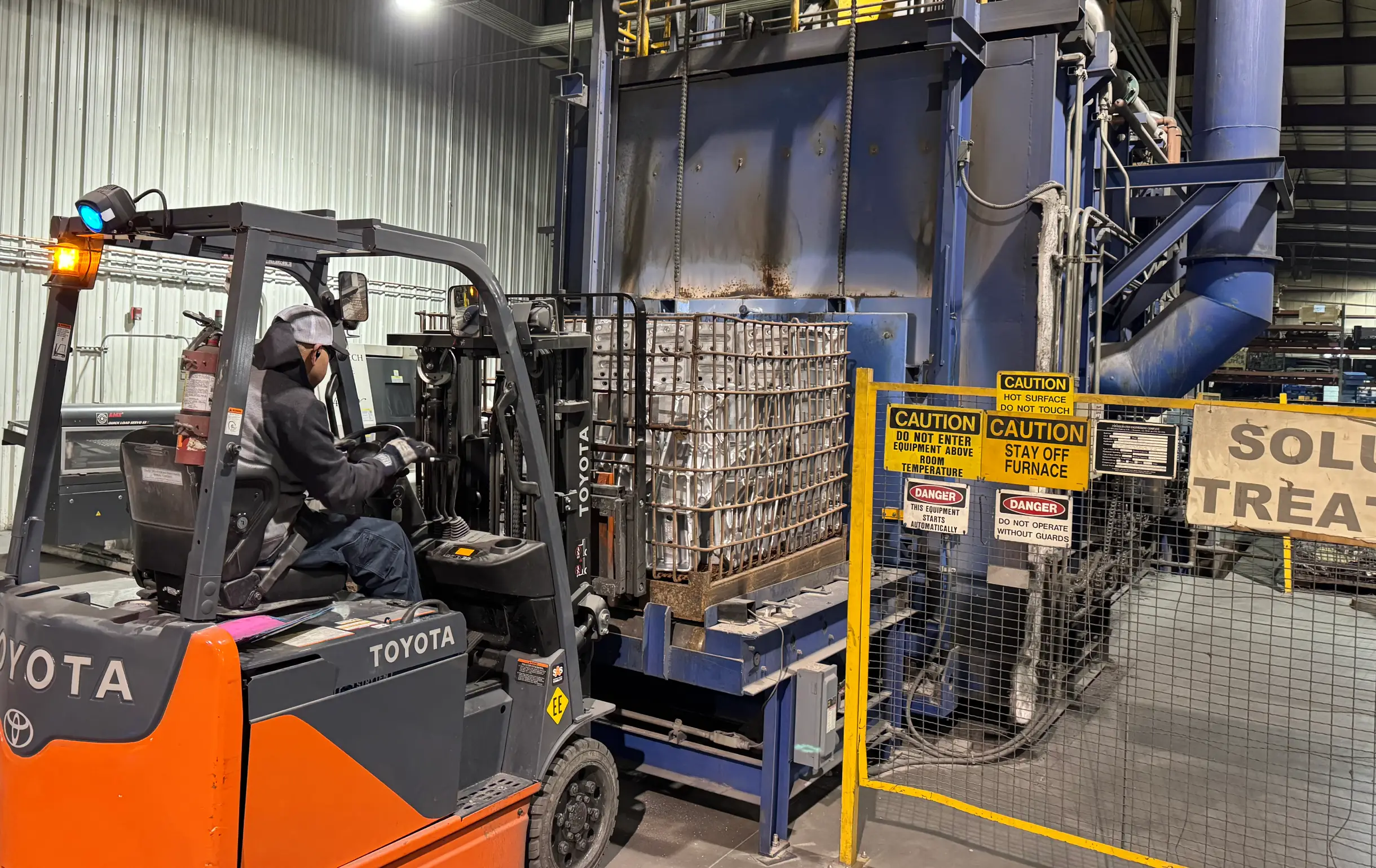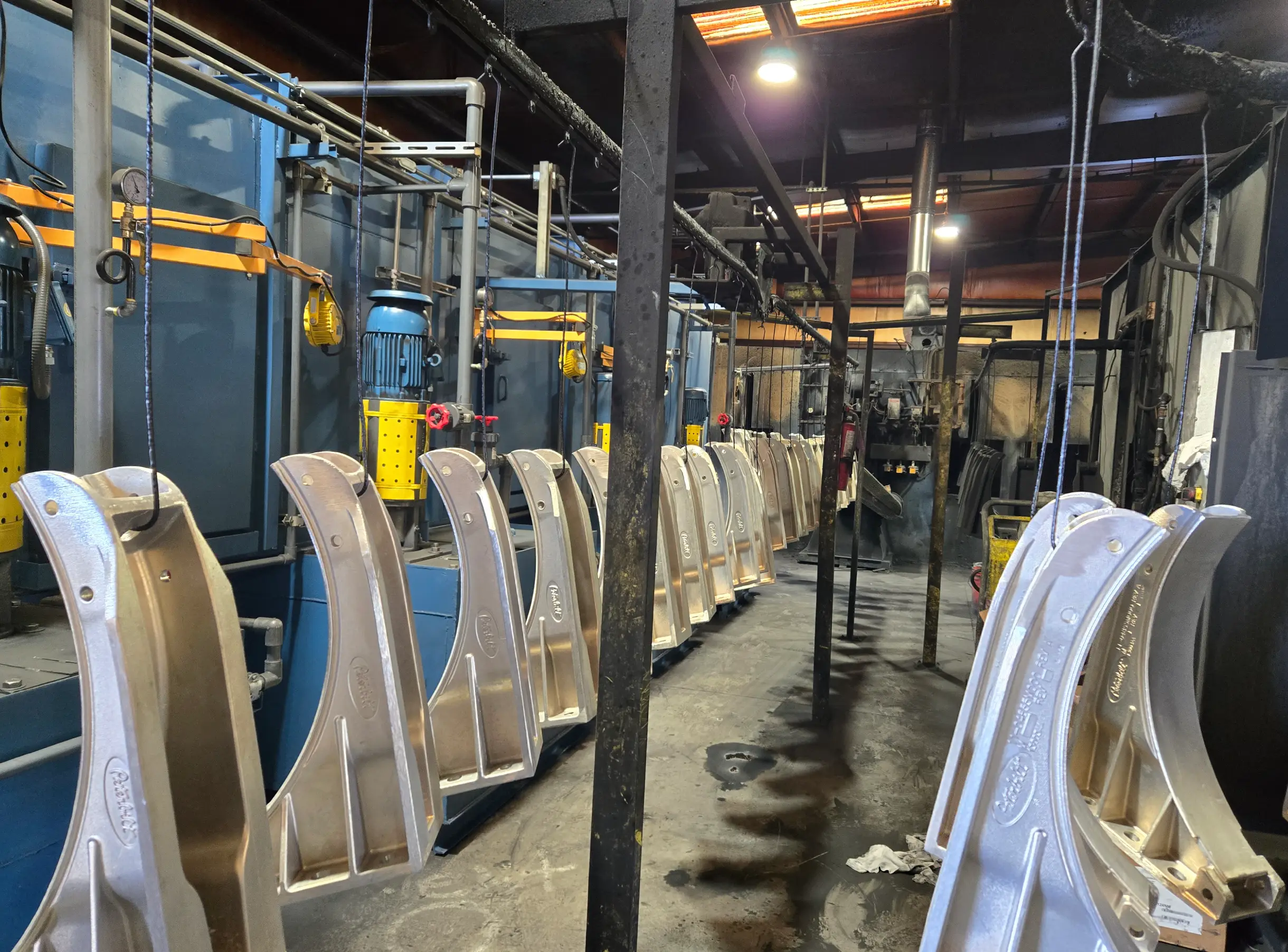Comprehensive aluminum casting solutions from concept to customer
At Production Pattern & Foundry, we provide a complete range of aluminum casting services under one roof, from initial pattern design through casting, heat treatment, machining, and finishing, our integrated approach ensures quality control and efficiency at every stage of production.
Our modern facility houses two dedicated foundries pouring high-quality aluminum castings in greensand and permanent mold. With over 80 years of experience, we deliver precision aluminum components for a wide range of industries, including automotive, industrial equipment, aerospace, and consumer products.
Versatile casting process for complex geometries and low to high volume production
Superior surface finish and dimensional consistency for high production runs
Custom core production for creating complex interior geometries in castings
Expert pattern creation from CAD files or samples with reverse engineering
Precision secondary operations for tight tolerances and finished components
Controlled thermal processing to enhance material properties and performance
Sand casting is a versatile process where a mixture of sand, clay, and water is compacted to form each mold half. The term "greensand" means that the sand binder is not activated by heating or chemical reactions.
In our greensand foundry, we can mold either low or high volume jobs using any of the following methods:
A pattern is created using materials like wood or metal that will form the exterior shape of the part.
The pattern is packed with greensand in a flask consisting of a bottom (drag) and top (bottom) to create the mold.
If internal cavities are needed, sand cores are placed in the mold to form these spaces.
Molten aluminum is poured into the mold through a gating system, filling the cavity created by the pattern.
The metal cools and solidifies into the desired shape within the mold.
The casting is removed from the sand, and excess material is trimmed away.

Our sand casting capabilities are ideal for a wide range of components across multiple industries:
Our tilt-pour permanent mold process utilizes cast iron molds, machined to exacting tolerances. This helps to achieve near net shape, reducing the need for additional machining and providing excellent surface finish and dimensional accuracy.
We currently house 25 permanent mold machines which cast in sizes ranging from 0.5 lbs up to 57 lbs, and from 3" to 3' long, offering versatility for a wide range of component types.
The cast iron molds are precision-machined, assembled, and treated with a refractory coating (die wash) to prevent sticking and extend mold life.
Molds are heated to an optimal temperature to ensure proper metal flow and prevent premature solidification.
If internal features are required, sand or metal cores are positioned within the mold.
Using a tilt-pour mechanism, molten aluminum is gradually introduced into the mold cavity, ensuring smooth, controlled filling and reducing turbulence.
The aluminum solidifies rapidly against the metal mold, creating a fine grain structure with excellent mechanical properties.
The solidified casting is ejected from the mold, and gates and risers are removed through sawing, trimming, or machining operations.

Our permanent mold casting is ideal for applications requiring superior surface finish, dimensional accuracy, and excellent mechanical properties:
Some castings require no sand cores while some require several - it depends on the empty space needed in the casting. At PPF, we make all our Shell Cores and No Bake Cores in-house, and work with you during the design process to ensure that empty space is handled effectively and efficiently.
Our in-house core production capabilities give us complete control over quality, delivery times, and customization, allowing us to respond quickly to your changing requirements.
Shell cores are created using a mixture of sand and thermosetting resin that is heated to form a hard "shell" with excellent strength and dimensional stability. These cores are ideal for:
No Bake cores use a chemical binder system that cures at room temperature. These cores provide:
A precision-manufactured core box is created to form the desired core shape.
Sand is mixed with the appropriate binding system - either thermosetting resin for shell cores or chemical binders for no-bake cores.
The prepared sand mixture is introduced into the core box and formed through either heat application (shell) or chemical reaction (no-bake).
Cores are properly cured, and any excess material is removed to ensure dimensional accuracy.
Each core is inspected for defects, dimensions, and hardness to ensure it will perform correctly during casting.

Effective core design is critical to successful casting. Our experienced engineers work with you to optimize cores for:
Our sand core capabilities serve industries requiring complex internal geometries:
From concept, CAD files, or sample parts, our design team can create the best pattern mold possible to meet your end requirement. We have trained in-house engineers ready to accept your CAD files with Solidworks and Surfcam to ensure maximum compatibility.
With Zeiss ATOS 5 3D Scanning capability, PPF can reverse engineer your sample part in extreme definition and create CAD files for replication. Or we can take your drawings and make them into a reality.
Direct import of your CAD files with Solidworks and Surfcam compatibility for maximum efficiency.
Zeiss ATOS 5 3D Scanning capability for reverse engineering sample parts with extreme precision.
Development of new patterns based on drawings or concepts with expert precision.
Retrofit and modification of existing patterns to optimize performance or adapt to changing requirements.
Our engineers analyze your part requirements, including geometry, tolerances, and functional needs.
We determine the optimal casting method and material for your part based on application requirements.
Our team designs patterns with appropriate shrinkage allowances, draft angles, and parting lines for optimal casting results.
Using advanced MAGMASOFT software, we simulate mold filling, solidification, and cooling to identify and resolve potential issues.
Patterns are created to precise specifications using appropriate materials for the selected casting process.
Initial castings are produced and analyzed to ensure the pattern delivers the required quality and specifications.

We create various types of patterns optimized for different casting processes:
Our design team works closely with your engineers to ensure optimal pattern design for manufacturability, cost-effectiveness, and quality. We welcome collaboration at every stage of the process to achieve the best possible results.
Our secondary operations include 14 CNC machines and 2 Robotic trim cells to provide precise machining capabilities for your aluminum castings. This allows us to deliver components with tight tolerances and superior finish.

Our machining operations are supported by rigorous quality control processes:
Our secondary operations include a continuous batch solution oven and 4 age ovens, allowing us to provide complete heat treatment services in-house. This gives us full control over the metallurgical properties of your aluminum castings.

Our continuous batch solution oven heats aluminum castings to near-melting temperatures to dissolve alloying elements into solid solution, preparing the material for age hardening.
Rapidly cooling the heated castings to lock in the solid solution state, creating a supersaturated material ready for aging.
Our precision aging ovens provide controlled temperature environments where alloying elements precipitate out of solution, significantly enhancing mechanical properties.
We provide heat treatment for a variety of aluminum alloys including:
Our full powder coating shop provides complete finishing capabilities for your aluminum castings, delivering a durable, attractive, and protective surface treatment. This allows us to offer true concept-to-customer service, with all processes under one roof.
Castings undergo thorough cleaning, degreasing, and surface preparation to ensure optimal coating adhesion.
Application of specialized conversion coatings to enhance corrosion resistance and improve powder adhesion.
Electrostatically charged powder is applied evenly to the grounded part, creating a uniform coating on all surfaces.
Parts enter a high-temperature oven where the powder melts, flows, and chemically cross-links to form a durable finish.
Finished parts undergo thorough inspection for coating thickness, adhesion, appearance, and performance characteristics.

Our powder coating capabilities include a variety of finishes and options to meet your specific requirements:
Extensive color selection from standard RAL colors to custom color matching for brand consistency.
From smooth gloss to textured finishes that hide minor surface imperfections.
Metallic, hammertone, wrinkle, and other decorative finishes for unique aesthetic appeal.
Specialized coatings for enhanced UV resistance, chemical resistance, or high-temperature applications.
By offering powder coating services alongside our casting and machining capabilities, we provide a complete concept-to-customer solution that reduces logistics costs, minimizes handling damage, shortens lead times, and ensures consistent quality throughout the production process.
From concept to customer, we deliver high-quality aluminum castings with precision and reliability. Contact us today to discuss your project requirements.
Contact Us Today